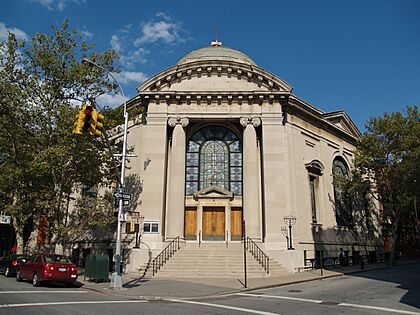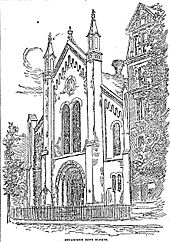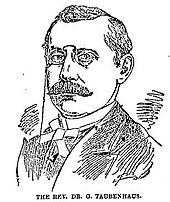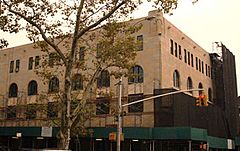Congregation Beth Elohim facts for kids
Quick facts for kids Congregation Beth Elohim |
|
|---|---|
|
Hebrew: בֵּית אֱלֹהִים
|
|

Sanctuary main entrance
|
|
| Religion | |
| Affiliation | Reform Judaism |
| Ecclesiastical or organisational status | Synagogue |
| Leadership |
|
| Status | Active |
| Location | |
| Location | 274 Garfield Place and Eighth Avenue, Park Slope, Brooklyn, New York City, New York |
| Country | United States |
| Architecture | |
| Architect(s) |
|
| Architectural type | Synagogue |
| Architectural style | |
| Date established | 1861 (as a congregation) |
| Groundbreaking |
|
| Completed |
|
| Specifications | |
| Direction of façade | West (Sanctuary) |
| Capacity | 1,200 worshippers |
| Dome(s) | One |
| Materials | Cast stone |
Congregation Beth Elohim (which means "House of God" in Hebrew) is a historic synagogue in Brooklyn, New York City. It's also known as the Garfield Temple or Eighth Avenue Temple. This synagogue follows Reform Judaism, a modern way of practicing the Jewish faith.
It was started in 1861 by people who wanted a more liberal approach to their faith. Over the years, the congregation built beautiful buildings. The main synagogue, finished in 1910, has a grand Classical Revival style. Later, in 1929, they added the "Temple House," which mixes Romanesque Revival and Art Deco styles. Both buildings are important landmarks in New York City.
The synagogue faced tough times, especially during the Great Depression. Membership went down, but it grew again after World War II. In recent years, programs for kids and families helped bring many new members. By 2009, it was one of the largest and most active Reform synagogues in Brooklyn. It was even called one of America's "Most Vibrant" Jewish congregations by Newsweek magazine. In 2021, Congregation Beth Elohim merged with the Union Temple of Brooklyn.
Contents
Early Years: Pearl Street Synagogue
Congregation Beth Elohim began on September 29, 1861. Forty-one Jewish people from Germany and Bohemia started it. They wanted to make changes to their religious practices. The first services were held at Granada Hall.
- Men and women sat together, which was different from traditional synagogues.
- Services were in German and Hebrew.
A few months later, in 1862, they bought an old church building on Pearl Street. They renovated it and it became known as "the Pearl Street synagogue." By 1868, the congregation had grown to 103 members. Their Sunday school had almost 100 students.
In 1870, Beth Elohim officially started using "moderate reform services." They tried to move to a larger building on Schermerhorn Street, but it didn't work out. So, they returned to Pearl Street. They added an organ and a choir to the synagogue.
In 1882, the congregation decided to hire a new leader, Solomon Mosche. The younger members wanted a change. In 1883, Beth Elohim tried to merge with two other large Brooklyn synagogues, Baith Israel and Temple Israel. This was the third attempt, but it also failed.
Solomon Mosche became ill in 1884. He was replaced by 26-year-old William Sparger. Sparger was from Hungary and brought many new ideas. He made the sermon the most important part of the service. He also added Friday night services. Under his leadership, many more people started attending the synagogue.
Moving to State Street
Because of Sparger's new ideas, Beth Elohim quickly outgrew its Pearl Street building. In 1885, they bought a new building on State Street. It used to be a Congregational Church.
In 1891, William Sparger left to work at a larger synagogue in Manhattan. Beth Elohim then hired G. Taubenhaus as their rabbi and Mauritz Weisskopf as their cantor.
Rabbi Taubenhaus was born in Warsaw and was very smart. He studied Jewish texts from a young age. He had served in other synagogues before coming to Beth Elohim. His brother also became a rabbi at Beth Elohim's parent congregation.
By the early 1900s, English had replaced German in services. The synagogue had 106 members and about 300 students in its Sunday School. In 1901, Rabbi Taubenhaus left. The next year, Alexander Lyons became the first American-born rabbi for the congregation. He served for 37 years until his death in 1939.
In 1907, the women's auxiliary group was started. This gave women more say in how the synagogue was run.
New Buildings: Garfield Place and Eighth Avenue
Building the Sanctuary and Temple House
In 1908, the congregation bought land at Garfield Place and Eighth Avenue. They planned to build a new synagogue there. The new building was designed by Simon Eisendrath and B. Horowitz. Construction started in 1909 and finished in 1910.
The main synagogue building is in the Classical Revival style. It has five sides, representing the five books of Moses. The main worship area, called the sanctuary, could seat 1,200 people. Above the entrance, a Bible verse is carved in stone: "MINE HOUSE SHALL BE AN HOUSE OF PRAYER FOR ALL PEOPLE." The basement had classrooms and offices.
In 1925, there were talks about merging with Union Temple, another synagogue. But younger members worried about losing their synagogue's unique identity, so the merger didn't happen.
Instead, the congregation decided to build a second building. In 1928–1929, they built the six-story Temple House. This building was for all congregational activities. It was designed by Mortimer Freehof and David Levy. Its style was "Jewish Deco," a mix of Romanesque Revival and Art Deco.
The Temple House had many features:
- A chapel for smaller services.
- A large ballroom and social halls.
- Classrooms for the religious school.
- Meeting rooms and offices.
- Even a gymnasium and a swimming pool!
The building was decorated with symbols like the Star of David and the Menorah. It also had carvings of important figures and stories from the Hebrew Bible.
Challenges and Changes (1930s-1950s)
In 1931, Isaac Landman joined Rabbi Lyons as a leader of Beth Elohim. Landman was born in Russia and had a very interesting life. He was a leader in bringing different faiths together. He also edited a large Jewish encyclopedia.
During the Great Depression, many people faced financial hardship. Synagogue membership went down a lot. The synagogue even had trouble paying its mortgage. However, Beth Elohim still offered adult education classes during this time.
Rabbi Lyons passed away in 1939. Landman then became the sole rabbi. In 1938, Rabbi Lyons spoke out against Adolf Hitler's ideas about race. He encouraged people to boycott German goods.
After World War II, the synagogue's situation improved. In 1946, the bank threatened to take over the buildings because of unpaid mortgage. But the congregation worked hard to pay off the loan.
Eugene Sack joined as rabbi in 1946. He had been an army chaplain during World War II. He was also involved in discussions about the future of Reform Judaism. Rabbi Landman passed away suddenly in 1946, and Rabbi Sack led Beth Elohim for 35 years.
After the war, Beth Elohim made an important change: women could become full members. They could vote and hold leadership positions. The synagogue also started welcoming Jewish families from Eastern Europe.
In the 1950s, the synagogue fixed some building issues, like cracks in the ceiling and flooding in the basement. By 1953, Beth Elohim had grown to over 700 families. The religious school had more than 550 students. But in the 1960s, membership started to decline as families moved away.
Revitalization and Growth (1970s-Today)
By 1970, Beth Elohim faced challenges with fewer members. To help, they started one of the first nursery schools in the neighborhood. This, along with people moving back to the Park Slope area, helped bring Jewish families back to the synagogue.
In 1978, Gerald I. Weider joined as a young rabbi. He focused on programs for urban Jewish families. Under his leadership, Beth Elohim opened after-school and early childhood centers in 1978. They also started a day camp in the Temple House the next year.
The 1970s also saw a return to some more traditional practices in services. Some members started wearing head coverings. More Hebrew prayers were added to the Sabbath service. The synagogue buildings were recognized as important landmarks in 1973 and added to the National Register of Historic Places in 1980.
In 1985, Rabbi Weider and Beth Elohim worked with other synagogues to plan a liberal Jewish day school. The school opened in 1995 and grew to 38 students before becoming independent.
Throughout the 1980s and 1990s, Beth Elohim repaired and updated its buildings many times. They fixed the sanctuary ceiling, restored stained glass windows, and made the entrance accessible for people with disabilities.
In 2001, Janet Leuchter became the cantor. Rabbi Weider retired in 2006 after 28 years. He was followed by Andy Bachman. In 2007, Beth Elohim won an award for its excellent learning programs.
In 2009, Beth Elohim was known as the largest and most active Reform synagogue in Brooklyn. Even U.S. Senator Chuck Schumer was a prominent member. In September 2009, part of the sanctuary ceiling collapsed, but no one was hurt. A nearby church, Old First Reformed Church, offered its space for holiday services.
As of 2012, Beth Elohim was the oldest Brooklyn congregation still using its original name. Its pulpit was the oldest in continuous use in any Brooklyn synagogue. Andy Bachman, Shira Koch Epstein, and Marc Katz were the rabbis, and Gerald Weider was the rabbi emeritus. Joshua Breitzer was the cantor.
Andy Bachman became the senior rabbi in 2006. He believed in bringing more traditional practices into the Reform movement. He also helped attract many young adults to the synagogue. Shira Koch Epstein and Marc Katz also played important roles as rabbis.
On September 22, 2013, Beth Elohim celebrated its 150th anniversary. They dedicated a new Sefer Torah (Torah scroll). Members said it was the first Torah in New York City to be completed by a woman.
In June 2015, Andy Bachman left. In July 2015, Rachel Timoner became the Senior Rabbi. In April 2020, Congregation Beth Elohim began discussing a merger with Union Temple of Brooklyn. They officially merged on March 26, 2021.
Images for kids









